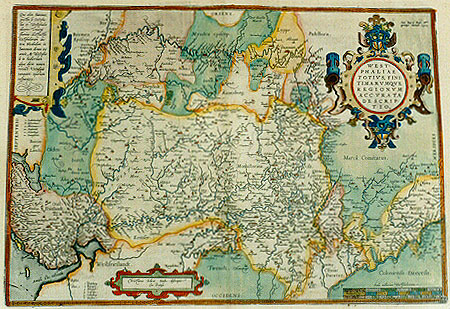Cartographica Neerlandica Background for Ortelius Map No. 91

Title:WEST:|PHALIAE | TOTIVS, FINI|TIMARVMQVE | REGIONVM | ACCVRATA | DESCRIP:|TIO. [An accurate representation of all of Westfalen and the borders of this area]. (Top right corner:) "Cum Imp. et Regiæ. Mtm. | priuilegio decennali .1579." [With an imperial and royal privilege for ten years .1579]. (Lower left cartouche:) "Christianus Schrot Sonsb. descripsit. | Cum Priuilegio". [Made by Christianus Schrot from Sonsbeck, with privilege]. Top left cartouche with 14 lines of text: "Qui olim Saxones, | postea se Ostpha:|los et Westphalos | dixere: Visurgi | flumine distinctos: | Ostphalorum au:|tem Vocabulum in | Saxonum denuo eu:|anuit. At Westpha:|li in hodiernum | usque diem nomen | retinêt. Vetusque | tanquam spurium | respuentes". [First the inhabitants called themselves Saxons, afterwards Ostphalians and Westphalians. They were separated by the river Weser. But the name of the Ostphalians changed again into Saxons, whereas the Westphalians retained their name to the present day. Thus the old name has been discarded by the Ostphalians as being inappropriate].
Plate size: 346 x 498 mm
Scale: 1 : 530,000
Identification number: Ort 91 (Koeman/Meurer: 85, Karrow: 1/120, van der Krogt AN: 2300:31).
Occurrence in Theatrum editions and page number:
1579/1580L2Add26a (250 copies printed) (first line ends: ver- ; last line, in cursive script, two columns: "Cranck broot, dun bier, langhe mile, | Qui non vult credere,loop da".),
1579L(A)40 (250 copies printed) (first line ends: ver- ; last line, in cursive script, two columns: "Cranck broot, dun bier, langhe mile, Qui non vult credere,loop da". ; W of title above io of regio in first text line.),
1579L(B)40 (250 copies printed) (first line ends: ver= ; last line, in cursive script, two columns: "Cranck broot, dun bier, langhe mile, Qui non vult credere,loop da". ; W of title above re of regio in first text line.),
1580GAdd26A (50 copies printed), (third but last line, centred like 3 lines above it: Sprichwort:),
1580/1589G40 (350 copies printed) (third but last line, centred like 3 lines above it: Sprichwort:),
1581F40 (400 copies printed) (last line, left aligned, in cursive script like the entire text: "tion de Saxe,composé par Crantzius."),
1584L46 (750 copies printed) (last line, in cursive script, two columns: "Cranck broot,dun bier,langhe mile, Qui non vult credere,loop da.") ,
1587F46 (250 copies printed) (last line, left aligned, in cursive script like the entire text: "tion de Saxe , composée par Crantzius".),
1588S46 (300 copies printed) (last line, left aligned: la legua muy tirada: si no lo quieres creer, ve lo a veer.),
1592L48, (525 copies printed) (last two lines in two columns, not quite left and right aligned, in cursive script: "Hospitium vile, Sunt in Westphalia;/Cranck broot, dun bier,langhe mile, Qui non vult credere,loop da". ; last line above poem, left aligned: vulgo dicitur:),
1595L51 (500 copies printed) (last line above poem: prouerbium rhytmicum vulgo dicitur: ; last two lines in two columns, not quite left and right aligned, in cursive script: "Hospitium vile, Sunt in Westphalia/Cranck broot, dun bier,langhe mile, Qui non vult credere,loop da".),
1598/1610/1613D42 (100 copies printed) (last 4 lines, one column somewhat left of the centre, in cursive script: "Hospitium vile/Cranck broodt,dun bier,langhe myle/Sunt in VVestphalia/Qui non vult credere loopt da."),
1598F53 (525 copies printed) (last line, italic script like the entire text, left aligned: "scription de Saxe,composée par Crantzius".),
1601L51 (200 copies printed) (last line above poem, left aligned: De hac regione hoc prouerbium rhytmicum vulgo dicitur: ; last two lines in two columns, not quite left and right aligned, in cursive script: "Hospitium vile, Sunt in Westphalia;/Cranck broot, dun bier,langhe mile, Qui non vult credere ,loop da".),
1602G53 or 26a (250 copies printed) (last line, centred like one line above it, partly in Gothic script: Seind in Westphalia, si non vis credere, lauff dar.),
1602S54 (250 copies printed) (last line, left aligned: la legua muy tirada : si no lo quieres creer, ve lo a veer.),
1603blank (Vri1)no text or page number,
1603L54 (300 copies printed) (text but not typesetting identical to 1609/1612L; 12th line from the top begins: nensi ac ; third line from the bottom, left aligned: De hac regione hoc prouerbium rhytmicum vulgo dicitur:),
1606E54 (300 copies printed) (last line, in two columns, italic like most of the text: "Kentish m[il]es, small drinke and brown bread, He that will not beleeue it, let him go see."),
1608/1612I59 (300 copies printed) (last two lines, in cursive script unlike the rest of the text, in two columns: "L'alloggiamento vile Sono in Westfalia;/Cranck broot ,dun bier ,langhe mile , Qui non uult credere ,loop da."),
1609/1612L58 (300 copies printed) (text, but not typesetting identical to 1603L; 12th line from the top begins: nensiac ; third line from the bottom, left aligned: De hac regione hoc prouerbium rhytmicum vulgo dicitur:),
1609/1612/1641S57 (325 copies printed) (last line, left aligned: legua muy tirada: si no lo quieres creer, ve lo a veer.).
Approximate number of copies printed: 6725.
States: 91.1 as above.
91.2: between 1584 and 1587 the hachuring along the coastlines was extended from about 2 to about 6 mm. Horizontal hachuring was added on the frame of the Schrot cartouche in the lower left.
91.3: during or after 1612S, the date was removed.
Note that from the very first edition onwards, there is a crack in the copperplate located about 25 mm above the lower left corner, which in the course of the life of this plate grew in length from about 15 to about 25 mm.
Cartographic sources: based on a manuscript map by Christian Sgroten from 1565 made at the request of Philip II for 700 Pounds (Karrow 70.7 p. 482, Meurer p. 239).
For questions/comments concerning this page, please e-mail info@orteliusmaps.com.